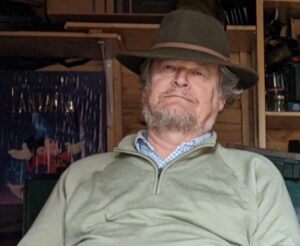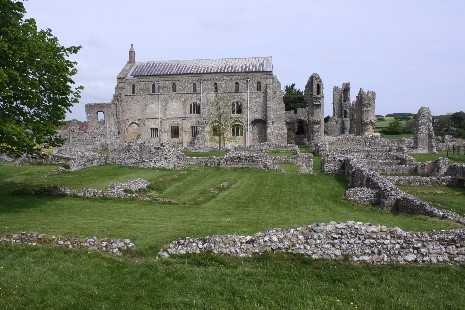29 April 2021
Hiding Away
A Church reborn?
By J.R. Thomas
 Dear old Henry VIII. We remember for two things – six wives, and for dissolving the monasteries. The latter, thank you Henry, has given us some of the most peaceful and beautiful ruins in the word. The ruins tend to be by now ruins of ruins, the bits the locals left behind after they had recycled the extensive monastery buildings for home and barn building nearby (the monastery lands were mostly recycled by sharp Tudor businessmen into the founding of many an English aristocratic dynasty and fortune). Our photograph shows Binham in Norfolk, where, unusually, the nave of the priory church remains intact and in use as the village church.
Dear old Henry VIII. We remember for two things – six wives, and for dissolving the monasteries. The latter, thank you Henry, has given us some of the most peaceful and beautiful ruins in the word. The ruins tend to be by now ruins of ruins, the bits the locals left behind after they had recycled the extensive monastery buildings for home and barn building nearby (the monastery lands were mostly recycled by sharp Tudor businessmen into the founding of many an English aristocratic dynasty and fortune). Our photograph shows Binham in Norfolk, where, unusually, the nave of the priory church remains intact and in use as the village church.
Those pre-Henrician monasteries would not have been as peaceful as they are today. The monks or nuns, although often silent orders, had intensive programmes of sung and spoken worship, and the monastic life was supported by extensive commercial activities – farming, milling, brewing, timber works, and so on. But all this activity was generally in remote places, so that at least the religious inhabitants could live contemplative and prayerful lives. When the monasteries went, so did the possibilities of peaceful religious withdrawals from life, at least in the British Isles. In mainland Europe monastic communities lasted a lot longer, until the rationality of the late C18th and early C19th (and Napoleon) swept much, but not all, away.
In the late C19th century the idea of retreat from the world, of contemplation as a proper way of living, began to return. Some of this was due to the foundation of various Catholic monasteries in Britain, often allied with Catholic schools such as Ampleforth and Downside (not so peaceful perhaps). There monks lived their sequestered lives, but in many cases also fulfilled more worldly missions as teachers. Gradually, however, materialism, or simple worldly comforts, reduced the attractions of the monastic life. The numbers living in closed or semi closed monasteries slowly declined from what seems to have been the modern peak before World War One, and are now at such low levels that many monasteries (particularly nunneries) have had to close, or retreat to suburban semi’s – which cannot be ideal for a quiet contemplative way of life.
The concept of retreat, though, has grown in popularity in modern society, although this tends to usually mean a retreat for a few days or a couple of weeks, rather than for a lifetime. No doubt medieval monks might, in a kindly way, rather sneer at a four day retreat – not much abstinence or deprivation there – but even so it can be a way of gaining the silence and simplicity to refocus a life – or simply focus on a problem.
One of the unexpected results of Lockdown and Covid and our sitting at home bored out of our minds with our version of sequestered life might turn out to be a renewed interest in the religious life. Perhaps not in the Church of England life; the poor Anglican church being seemingly lost in a dust storm of bureaucracy, regulation, financial pressure, poor leadership, and almost satirical political correctness. But may there be coming a true turning aside from the acquisition of things, to the acquisition of peacefulness and spirituality? Could we see a rush, even a miniature rush, to the closed religious life, to monastic communities remote from the world, with basic facilities but a focus on higher planes? This does not have to be Catholic or Anglican, but could be Orthodox Christian (membership of both the Russian and Greek branches are showing signs of growth in the UK apparently) or (a very popular option for retreatants at one time) Buddhist communities, either in the UK or in the Far East.
A number of writers have explored this approach to life. The most famous was perhaps Patrick Leigh Fermor, of whom it might be said he had a lot to retreat from, and not infrequently did. His book, A Time to Keep Silence, is a hymn of praise to monastic retreats, where PLF tried a number of monasteries of different Catholic orders, including the Cistercians and Trappists, also venturing to Mount Athos for an Orthodox experience (and producing a book about that). He recommended such abstinence for recharging of batteries and for inspiration (it has to be said that his diaries suggest that he was not as strict with himself as his hosts might have desired). Peter Levi, an interesting writer on many things religious, also is worth reading in The Frontiers of Paradise, though Mr Levi preferred to write about the life monastic rather than experiencing it. Now we have a new, and apparently rapid selling, exploration of the subject in The Interior Silence by Sarah Sands, who may be known to readers as editor of the London Evening Standard, and then editor of the BBC Today programme until late last year.
This ought to be a fascinating book; in some respects it is. Ms Sands is an erudite journalist and the combination of a female approach to religious solitude and her insights into the lives of others should give us a fresh view of retreat. Ms Sands has two further inspirations – a wall of the ruined Cistercian nunnery, Marham Abbey, at the bottom of her garden, and a seemingly generous travel budget. Maybe it is the latter which has led to what is, alas, a somewhat disappointing book. One cannot help the feeling that if Sarah had needed to economise and thus travel less and spend longer in her chosen retreats she, and we, might have got more out of it. She might also have got more if she had, like Leigh Fermor, being a solitary soul in her silent spiritual quest. But she generally takes along her adult irritatingly leftie daughter, or on occasions her husband, and rarely stays anywhere more than a couple of nights. That makes for an interesting travel book, but not a retreat book. Nevertheless, she writes well and her journalist’s trained mind rootles out some of the difficulties and benefits of the silent contemplative life, from a monastery in Japan to Maria Von Trapp’s base in Salzburg, via Lindisfarne (though the latter is a ruin and St Cuthbert long ago moved to Durham Cathedral), not omitting the Egyptian desert. Indeed, an impressive travel budget.
She had the misfortune to be doing her research travels in the time of Covid, and this did limit her intended targets. But at least she did achieve one of them – to be able to sleep more soundly. No doubt giving up her BBC Today job helped that as well; no more 3.30am starts. So, a broad exploration of the life monastic, of silence, of commune and solitariness, both historic and present day. But what is does not do is explore how suited we are, how much we might benefit, from long-term withdrawal from the material world. After times when we have had a degree of solitude forced upon us, we may come to see in our souls that this is not entirely a bad thing to experience from time to time. A little deprivation, a modicum of solitude, a rejection of material comforts might just, as it seemed to do for our medieval forebears, give us the peace we crave, and the patience to put up with the noise of others.
Sarah Sands; The Interior Silence, published 2021 by Short Books RRP £12.99


